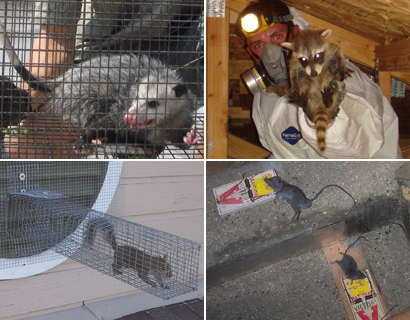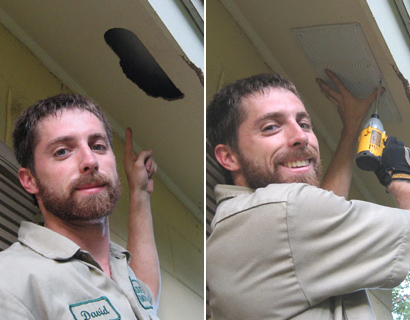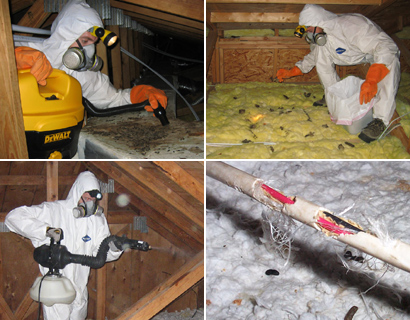- How We Solve Texas Wildlife Problems
How We Solve Austin Wildlife Problems
INSPECTION: Once on site, we will perform a full inspection of your home and property. This allows us to use the correct strategy and traps. If the animals are in an attic, a full building inspection is crucial, including the following:
- All ground-level areas, such as piper or A/C line entry & exit areas, A/C chase bottoms, ground-level vents, etc.
- All mid-level areas, such as dryer vents, siding gaps, first floor eaves or dormers, etc.
- We inspect the entire roof, including all plumbing stacks, ridge caps, vents, and other potential gaps or holes.
- We also inspect inside your attic, to identify animals and damage they have caused.
- If the animals are outside, we notice many subtle clues that will assist us in a successful strategy.
TRAPPING, EXCLUSION, REMOVAL: Once we understand what animal species we are dealing with, and the problem, we use the most effective means of removing the animals. We use dozens of different types of traps.
- Trapping - If trapping the animal(s) in live cage traps, trap type, set, and location are crucial to success.
- Exclusion - Oftentimes, we are able to simply set one-way doors or other exclusion devices that allow the animals inside a building to safely exit, but never get back inside.
- Removal By Hand - Sometimes we actually remove animals by hand, or with special tools like snare poles.
- The Law - In all cases, we obey state and local laws regarding wildlife, but aim to take the most humane approach.
ENTRY HOLE REPAIRS: Repairs are a crucial step in the wildlife removal process. In many cases, such as bat or rodent control, the job cannot be performed without detailed repairs, and in all cases, sealing the entry holes shut ensures that no future wildlife will ever enter your home.
- 100% of the entry holes must be found, and sealed shut, or the job is not complete.
- Our repairs are professional contractor grade, look good, and when applicable we use steel, which rodents such as rats or squirrels are unable to chew through.
- We give a written guarantee on our repairs against any future animal entry.
ATTIC DECONTAMINATION SERVICES: It may be desirable to clean your attic after we've removed the animals. They can leave behind large amounts of droppings, urine, hair, oils, food, nesting material, and so on. These remnants can attract insects like cockroaches, and the scent left behind can encourage new animals to chew their way into your house. You might experience odor problems from the waste. It's possible that mold will grow on waste areas.
- We remove or vacuum all droppings, or remove all the soiled insulation.
- We fog the attic with a special enzyme-based cleaner that destroys any organic matter and deodorizes the space.
- We repair damage, such as ductwork, electrical wires, pipes, insulation, and more.
Have you noticed that something has been digging holes near your shed or porch? You could have opposums living under your shed or porch. Give us a call before these critters start nesting and causing damage to your property. Our company specializes not only in trapping and removing wildlife critters, but we also handle repairs and prevention. We proudly service the Austin area, as well as the following cities: Anson, Bailey, Baird, Bangs, China, Castle Hills, Dalhart, Danbury, Dallas, Dayton, Early, Eagle Lake, Fairfield, Falls City, Farmersville, Ganado, Gatesville, Hallsburg, Hamilton, Marshall, Mart, Naples, Nash, Oak Leaf, Oak Point, Palestine, Palm Valley, Round Rock, Cedar Park, Georgetown, and Pflugerville. We also service the following counties: Anderson County, Houston County, Andrews County, Bexar County, Angelina County, Nacogdoches County, Aransas County, Burleson County, Milam County, Burnet County, Bell County, Williamson County, Caldwell County, Bastrop County, Gonzales County, Calhoun County, Jackson County, Matagorda County, Victoria County, Bosque County, and Cameron County.
Other Austin animal pest control topics:
Where Should You Relocate a Squirrel
How to Handle Raccoons on Your Roof
What is a Garter Snake
What Kind of Damage do Mice Cause
What do Wildlife Rehabilitators do with Texas Armadillos?
Gopher Prevention Tips
To learn more about our services, visit the Austin wildlife control home page.
This month's wildlife how-to article: The Diamondback Rattlesnake
The Diamondback Rattlesnake
Appearance
Considered as the largest venomous snake in the entire North America, the diamondback rattlesnake, is a pit viper that can grow up to eight feet long and weigh as much as ten pounds! These creatures are easily identified by their black or brown diamond patterns that run down the entire length of their body - hence the name "diamondback". These diamond patterns are outline by a light yellow shade. At the end of its tail is unique "series of hollow segments" that makes up it's rattle and when shaken vigorously, creates that distinct rattlesnake sound. During times of poor visibility, the diamondback mostly relies on their heat sensing pits (located between the eyes and nostrils) so that they can effectively catch their prey.
Biology
In the United States there are two types of diamondback rattlesnakes based on location:
• Eastern diamondback rattlesnake (Crotalus adamanteus)
• Western diamonback rattlesnake (Crotalus atrox)
Between the two, the eastern diamonback is the larger one. In fact, it is the largest of the thirty-two known species of rattlesnakes across the world. Both are highly venomous snakes!
Life cycle
Diamondback rattlesnakes in captivity end up living up to 22 or 25 years. They reach their sexaul maturity in about three years. As soon as that happens, mating occurs sometime in the spring when they awake from their long winter hibernation. The gestation period of these rattlesnakes often lasts up to 167 days and during the birth, it may take up to three to five hours. A female diamonback will have somewhere between ten and twenty live young. After a few hours or so, the young will be strong enough to leave the protection of their mother and will start searching for their own food. Only the strongest of the young end up maturing into adulthood as many end up dying in their first winter due to:
• Lack of food
• Freezing temperatures
• Predators
Habitat
In the United States, diamondbacks collectively cover a big majority of the south, south-west and west United States as well some parts of Mexico.
These rattlesnakes are often found in:
• Thick brush
• Vegetation
• Dry, rocky landscapes
• Under fallen trees and logs
Diet
As with most snakes, rattlesnakes are carnivorous and in particular, enjoy rodents.
Other food sources of diamondbacks are:
• Rabbits
• Birds
A rattlesnake of this kind will hunt by ambushing its prey. It needs a relatively large amount space in order to sneak up on its prey. They will inject their prey with venom but instead of eating it right away, will then allow the animal to flee. It will then follow the dead animal's scent trail which then it will consume the carcass whole.
Behavior
A misconception of these rattlesnakes is that they are highly aggressive creatures. The truth is, they aren't! The rattling sound that it produces is not a sign of aggression but a warning for the would be aggressor to leave.





